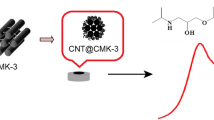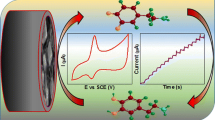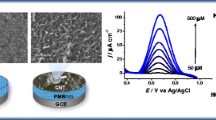Abstract
Pharmaceuticals and personal care products (PPCPs) have a significant impact on the environment and human health, due to their sometimes toxic and carcinogenic characteristics. Therefore, an innovative chemosensor was constructed for ultrasensitive determination of two typical PCCPs (hydroquinone (HQ) and catechol (CC)) in several minutes. The homemade chemosensor (UiO-67@GO/MWCNTs) consisted of MOF(UiO-67), graphene oxide (GO), and multi-walled carbon nanotubes (MWCNTs) composites; it was a networked, structurally sparse, porosity-rich, homogeneous octahedral composite, and had ultra-high electrical conductivity, which provided lots of active adsorption sites, promote charge transfer, and enrich lots of molecules to be measured in a few minutes. The prepared electrochemical sensor showed good long-term stability, applicability, reproducibility, and immunity to interference for the determination of HQ and CC, with a wide linear range of response of 5.0 ~ 940 µM for both HQ and CC, and a low limit of detection with satisfactory recoveries. In addition, a new strategy of using MOF composites as the basis for electrochemical determination of organic small molecules was established, and a new platform was constructed for the quantitative determination of organic small molecules in various environmental samples.
Graphical Abstract









Similar content being viewed by others
References
AbdelHamid A, Elgamouz A, Khanfer M, Kawde A-N (2023) COVID-19 chloroquine drug detection using novel, highly sensitive SnO2-based electrochemical sensor. Arab J Chem 16(5):104674. https://doi.org/10.1016/j.arabjc.2023.104674
Anil Kumar A, Kumara Swamy BE, Shobha Rani T, Ganesh PS, Paul Raj Y (2019) Voltammetric determination of catechol and hydroquinone at poly(murexide) modified glassy carbon electrode. Mater Sci Eng C 98:746–752. https://doi.org/10.1016/j.msec.2018.12.055
Huang H, Chen Y, Chen Z, Chen J, Hu Y, Zhu JJ (2021) Electrochemical sensor based on Ce-MOF/carbon nanotube composite for the simultaneous discrimination of hydroquinone and catechol. J Hazard Mater 416:125895. https://doi.org/10.1016/j.jhazmat.2021.125895
Wang J, Yang J, Xu P, Liu H, Zhang L, Zhang S, Tian L (2020) Gold nanoparticles decorated biochar modified electrode for the high-performance simultaneous determination of hydroquinone and catechol. Sens Actuators B 306:127590. https://doi.org/10.1016/j.snb.2019.127590
Nsanzamahoro S, Mutuyimana FP, Han Y, Ma S, Na M, Liu J, Ma Y, Ren C, Chen H, Chen X (2019) Highly selective and sensitive detection of catechol by one step synthesized highly fluorescent and water-soluble silicon nanoparticles. Sens Actuators B 281:849–856. https://doi.org/10.1016/j.snb.2018.11.016
Guo J, Wu S, Wang Y, Zhao M (2020) A label-free fluorescence biosensor based on a bifunctional MIL-101(Fe) nanozyme for sensitive detection of choline and acetylcholine at nanomolar level. Sens Actuators B Chem 312. https://doi.org/10.1016/j.snb.2020.128021
Beyeh NK, Kogej M, Åhman A, Rissanen K, Schalley CA (2006) Fliegende Kapseln: massenspektrometrische Detektion von Pyrogallaren- und Resorcinaren-Hexameren. Angew Chem 118(31):5339–5342. https://doi.org/10.1002/ange.200600687
Cao Q, Xiao Y, Liu N, Huang R, Ye C, Huang C, Liu H, Han G, Wu L (2021) Synthesis of Yolk/Shell heterostructures MOF@MOF as biomimetic sensing platform for catechol detection. Sens Actuators B 329. https://doi.org/10.1016/j.snb.2020.129133
Zhao Y, Jiang Y, Mo Y, Zhai Y, Liu J, Strzelecki AC, Guo X, Shan C (2023) Boosting electrochemical catalysis and nonenzymatic sensing toward glucose by single-atom Pt supported on Cu@CuO core-shell nanowires. Small 19(18):e2207240. https://doi.org/10.1002/smll.202207240
Guo H, Wang D, Chen J, Weng W, Huang M, Zheng Z (2016) Simple fabrication of flake-like NH2-MIL-53(Cr) and its application as an electrochemical sensor for the detection of Pb2+. Chem Eng J 289:479–485. https://doi.org/10.1016/j.cej.2015.12.099
Zhang Y, Li K, Liu Y-Q, Kou X, Gong Y, Bai Y, Chu W (2023) ZIF-67-derived highly dispersed Co3O4 nanoparticles@hollow carbon chamfer cube-reduced graphene oxide for electrochemical detection of dopamine, acetaminophen and xanthine. J Alloy Compd 936:168155. https://doi.org/10.1016/j.jallcom.2022.168155
Ma L, Zhang X, Ikram M, Ullah M, Wu H, Shi K (2020) Controllable synthesis of an intercalated ZIF-67/EG structure for the detection of ultratrace Cd2+, Cu2+, Hg2+ and Pb2+ ions. Chem Eng J 395. https://doi.org/10.1016/j.cej.2020.125216
Daniel M, Mathew G, Anpo M, Neppolian B (2022) MOF based electrochemical sensors for the detection of physiologically relevant biomolecules: an overview. Coord Chem Rev 468:214627. https://doi.org/10.1016/j.ccr.2022.214627
Liang H, Luo Y, Li Y, Song Y, Wang L (2022) An immunosensor using electroactive COF as signal probe for electrochemical detection of carcinoembryonic antigen. Anal Chem 94(13):5352–5358. https://doi.org/10.1021/acs.analchem.1c05426
Mohan B, Kumari R, Virender, Singh G, Singh K, Pombeiro AJL, Yang X, Ren P (2023) Covalent organic frameworks (COFs) and metal-organic frameworks (MOFs) as electrochemical sensors for the efficient detection of pharmaceutical residues. Environ Int 175:107928. https://doi.org/10.1016/j.envint.2023.107928
Zhou M, Tang T, Qin D, Cheng H, Wang X, Chen J, Wågberg T, Hu G (2023) Hematite nanoparticle decorated MIL-100 for the highly selective and sensitive electrochemical detection of trace-level paraquat in milk and honey. Sens Actuators B Chem 376. https://doi.org/10.1016/j.snb.2022.132931
Wang F-F, Liu C, Yang J, Xu H-L, Pei W-Y, Ma J-F (2022) A sulfur-containing capsule-based metal-organic electrochemical sensor for super-sensitive capture and detection of multiple heavy-metal ions. Chem Eng J (Lausanne) 438:135639. https://doi.org/10.1016/j.cej.2022.135639
Li X, Liu Y, Zhang C, Wen T, Zhuang L, Wang X, Song G, Chen D, Ai Y, Hayat T, Wang X (2018) Porous Fe2O3 microcubes derived from metal organic frameworks for efficient elimination of organic pollutants and heavy metal ions. Chem Eng J (Lausanne) 336:241–252. https://doi.org/10.1016/j.cej.2017.11.188
Zhou D-D, Liu Q-Y, Chen M, Cao Y-W, Zhuang L-Y, Yang Z-H, Xu Z (2023) The synthesis, application and mechanism of a novel Zr-based magnetic MOFs adsorption material. J Environ Chem Eng 11(3):109666. https://doi.org/10.1016/j.jece.2023.109666
Koo W-T, Jang J-S, Kim I-D (2019) Metal-organic frameworks for chemiresistive sensors. Chem 5(8):1938–1963. https://doi.org/10.1016/j.chempr.2019.04.013
Small LJ, Henkelis SE, Rademacher DX, Schindelholz ME, Krumhansl JL, Vogel DJ, Nenoff TM (2020) Near-zero power MOF-based sensors for NO2 detection. Adv Func Mater 30(50):2006598. https://doi.org/10.1002/adfm.202006598
Han HS, You J-M, Seol H, Jeong H, Jeon S (2014) Electrochemical sensor for hydroquinone and catechol based on electrochemically reduced GO–terthiophene–CNT. Sens Actuators B Chem 194:460–469. https://doi.org/10.1016/j.snb.2014.01.006
Wang H, Hu Q, Meng Y, Jin Z, Fang Z, Fu Q, Gao W, Xu L, Song Y, Lu F (2018) Efficient detection of hazardous catechol and hydroquinone with MOF-rGO modified carbon paste electrode. J Hazard Mater 353:151–157. https://doi.org/10.1016/j.jhazmat.2018.02.029
Zhang S, Wang Y, Cao Z, Xu J, Hu J, Huang Y, Cui C, Liu H, Wang H (2020) Simultaneous enhancements of light-harvesting and charge transfer in UiO-67/CdS/rGO composites toward ofloxacin photo-degradation. Chem Eng J 381:122771. https://doi.org/10.1016/j.cej.2019.122771
Xiao P, Zhu G, Shang X, Hu B, Zhang B, Tang Z, Yang J, Liu J (2022) An Fe-MOF/MXene-based ultra-sensitive electrochemical sensor for arsenic(III) measurement. J Electroanal Chem 916:116382. https://doi.org/10.1016/j.jelechem.2022.116382
Lu M, Deng Y, Luo Y, Lv J, Li T, Xu J, Chen SW, Wang J (2019) Graphene aerogel-metal-organic framework-based electrochemical method for simultaneous detection of multiple heavy-metal ions. Anal Chem 91(1):888–895. https://doi.org/10.1021/acs.analchem.8b03764
Hira SA, Nallal M, Park KH (2019) Fabrication of PdAg nanoparticle infused metal-organic framework for electrochemical and solution-chemical reduction and detection of toxic 4-nitrophenol. Sens Actuators B 298. https://doi.org/10.1016/j.snb.2019.126861
Olorunyomi JF, White JF, Gengenbach TR, Caruso RA, Doherty CM (2022) Fabrication of a reusable carbon dot/gold nanoparticle/metal–organic framework film for fluorescence detection of lead ions in water. ACS Appl Mater Interfaces 14(31):35755–35768. https://doi.org/10.1021/acsami.2c09122
Wang S, Guo P, Ma G, Wei J, Wang Z, Cui L, Sun L, Wang A (2020) Three-dimensional hierarchical mesoporous carbon for regenerative electrochemical dopamine sensor. Electrochim Acta 360. https://doi.org/10.1016/j.electacta.2020.137016
Gu C, Wang Q, Zhang L, Yang P, Xie Y, Fei J (2020) Ultrasensitive non-enzymatic pesticide electrochemical sensor based on HKUST-1-derived copper oxide @ mesoporous carbon composite. Sens Actuators B 305. https://doi.org/10.1016/j.snb.2019.127478
Zhao Q, Du Q, Yang Y, Zhao Z, Cheng J, Bi F, Shi X, Xu J, Zhang X (2022) Effects of regulator ratio and guest molecule diffusion on VOCs adsorption by defective UiO-67: Experimental and theoretical insights. Chem Eng J 433. https://doi.org/10.1016/j.cej.2022.134510
Zhou D-D, Liu Q-Y, Chen M, Cao Y-W, Zhuang L-Y, Yang Z-H, Xu Z (2023) The synthesis, application and mechanism of a novel Zr-based magnetic MOFs adsorption material. J Environ Chem Eng 11(3). https://doi.org/10.1016/j.jece.2023.109666
Hobday CL, Marshall RJ, Murphie CF, Sotelo J, Richards T, Allan DR, Duren T, Coudert FX, Forgan RS, Morrison CA, Moggach SA, Bennett TD (2016) A computational and experimental approach linking disorder, high-pressure behavior, and mechanical properties in UiO frameworks. Angew Chem Int Ed Engl 55(7):2401–2405. https://doi.org/10.1002/anie.201509352
Huang P, Wang X, Zhao J, Zhang Z, Du X, Lu X (2022) Hollow Co-MOF-74 incorporated electrospun nanofiber membranes with hierarchical structures for enhanced removal of polycyclic aromatic hydrocarbons by drain-type adsorption. Chem Eng J 449:137759. https://doi.org/10.1016/j.cej.2022.137759
Wang Y, Zhao G, Zhang G, Zhang Y, Wang H, Cao W, Li T, Wei Q (2020) An electrochemical aptasensor based on gold-modified MoS2/rGO nanocomposite and gold-palladium-modified Fe-MOFs for sensitive detection of lead ions. Sens Actuators B 319. https://doi.org/10.1016/j.snb.2020.128313
Guo H, Liu B, Pan Z, Sun L, Peng L, Chen Y (2022) Electrochemical determination of dopamine and uric acid with covalent organic frameworks and Ox-MWCNT co-modified glassy carbon electrode. Colloids Surf A 648:129316. https://doi.org/10.1016/j.colsurfa.2022.129316
Huang R, Liao D, Chen S, Yu J, Jiang X (2020) A strategy for effective electrochemical detection of hydroquinone and catechol: decoration of alkalization-intercalated Ti3C2 with MOF-derived N-doped porous carbon. Sens Actuators B 320:128386. https://doi.org/10.1016/j.snb.2020.128386
Chen H, Wu X, Lao C, Li Y, Yuan Q, Gan W (2019) MOF derived porous carbon modified rGO for simultaneous determination of hydroquinone and catechol. J Electroanal Chem 835:254–261. https://doi.org/10.1016/j.jelechem.2019.01.027
Funding
This work was generously supported by the National Natural Science Foundation of China (No. 22266031); the National Natural Science Foundation of Gansu Province, China (No. 22JR5RA134); the National Natural Science Foundation Youth Science and Technology Fund Project of Gansu Province, China (No. 23JRRA1472); the Science and Technology Fund Project of Lanzhou, China (No. 2023–3-71, 2023–3-42); the Program for Innovative Research Group of Gansu Province, China (No.1210RJIA001); Industrial Support Plan of Education Department of Gansu Province (No. 2021cyzc-01); and the Funds for Creative Research Groups of Gansu Province (21JR7RA160).
Author information
Authors and Affiliations
Corresponding author
Ethics declarations
Conflict of interest
The authors declare no competing interests.
Additional information
Publisher's Note
Springer Nature remains neutral with regard to jurisdictional claims in published maps and institutional affiliations.
Supplementary Information
Below is the link to the electronic supplementary material.
Rights and permissions
Springer Nature or its licensor (e.g. a society or other partner) holds exclusive rights to this article under a publishing agreement with the author(s) or other rightsholder(s); author self-archiving of the accepted manuscript version of this article is solely governed by the terms of such publishing agreement and applicable law.
About this article
Cite this article
Wang, X., Ma, Y., Ru, J. et al. One-step solvent thermal synthesis of 3D networked MOF composites for preparation of an ultrasensitive chemosensor for hydroquinone and catechol. Microchim Acta 191, 274 (2024). https://doi.org/10.1007/s00604-024-06349-6
Received:
Accepted:
Published:
DOI: https://doi.org/10.1007/s00604-024-06349-6




